Do you have a Griswold cast iron skillet and want to know its age or how to identify it using Logos? In this article, you can learn to date and recognize your Griswold cast iron using markings and logos.
I will focus on the dates and logos for collectible cast iron skillets manufactured by Selden & Griswold and Griswold Manufacturing Company between 1873 and 1957.
Table Of Contents
- Selden & Griswold cast iron
- Erie cast iron
- Griswold cast iron skillet logos.
- Victor cast iron
- Iron Mountain
- Good Health cast iron.
- Best Made skillets
- Puritan cast iron
- Merit cast iron
Learn To Date And Identify Your Griswold Cast Iron.
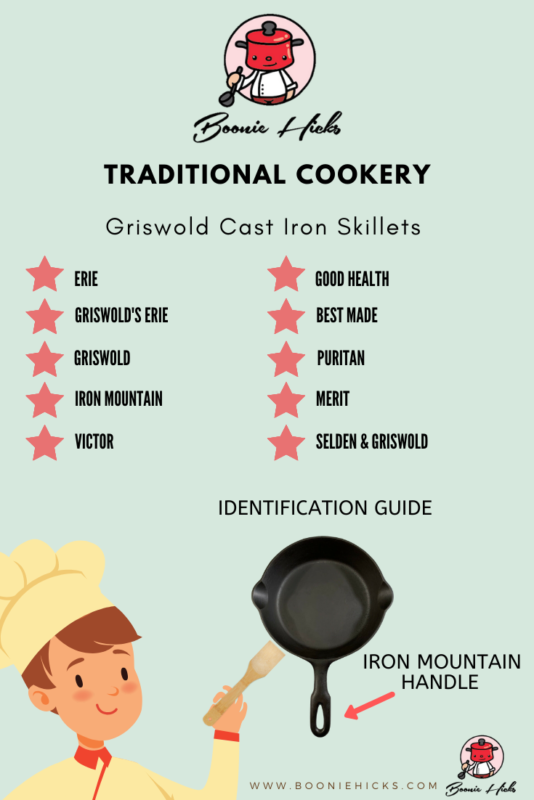
Griswold Manufacturing Background
Origins | Griswold Manufacturing Company dates back to 1868 when it was a small operation making door hinges. |
Selden & Griswold Manufacturing Company (1873-1884) | The Selden and Griswold family business became the Selden & Griswold Manufacturing Company. |
Griswold Manufacturing Company (1885-1957) | The company grew to one of America’s largest and most respected cast-iron manufacturers of the 20th century. |
Reasons For Collectibility | Cast Iron collectors highly regard Griswold cast iron skillets, and they are sought-after because of their smooth cooking surfaces and lighter weight. |
Desired And Rare Skillets | Look out for the first series of Erie and Erie Spider skillets. These two skillets stand out as the most sought-after by collectors. Also, rare sizes such as the Griswold #13 and #20 do not come up for sale often, but these large skillets can sell for a handsome sum when they do. |
| Most Valuable Griswold Skillets | The Erie Spider and Griswold 13 can cost a pretty penny. But the most valuable Griswold skillet is your family skillet. Family skillets vary in size and condition and have various logos. However, they are the most treasured and loved family heirlooms. |
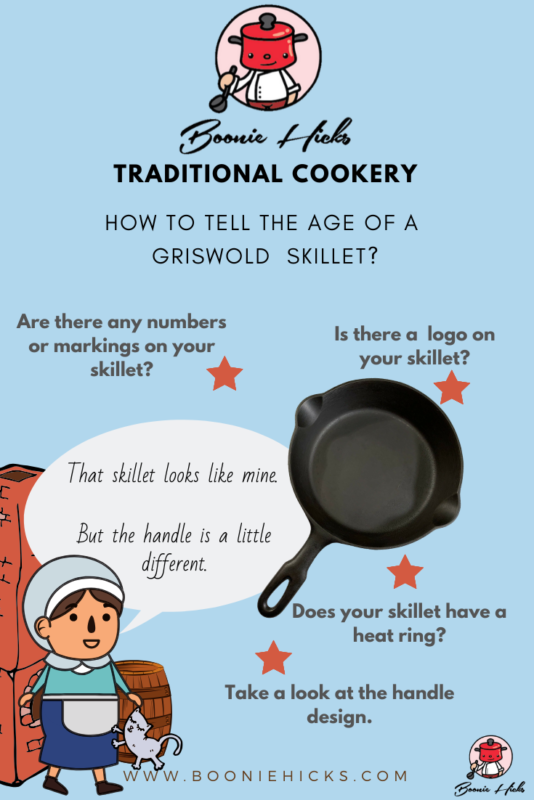
Selden & Griswold Cast Iron 1873-1884
Matthew Griswold and two brothers from the Selden teamed up and started to make door hinges in 1868. Their factory was known as the Butt Factory, named after the door hinge (butt hinge) manufactured in the casting works.
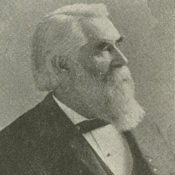
Selden & Griswold started to manufacture hollowware in 1873. But most of the cookware with this logo was probably made in the 1880s. Even though Mathew Griswold bought out the company in 1884, he still used the Selden Griswold logos.
After all, Griswold would have taken a lot of time and money to register new patent designs. And to make new molds. Check out our other article to learn about the history of Griswold Manufacturing. Wikipedia also has some information on Griswold. Although I hope my article is a little more detailed.
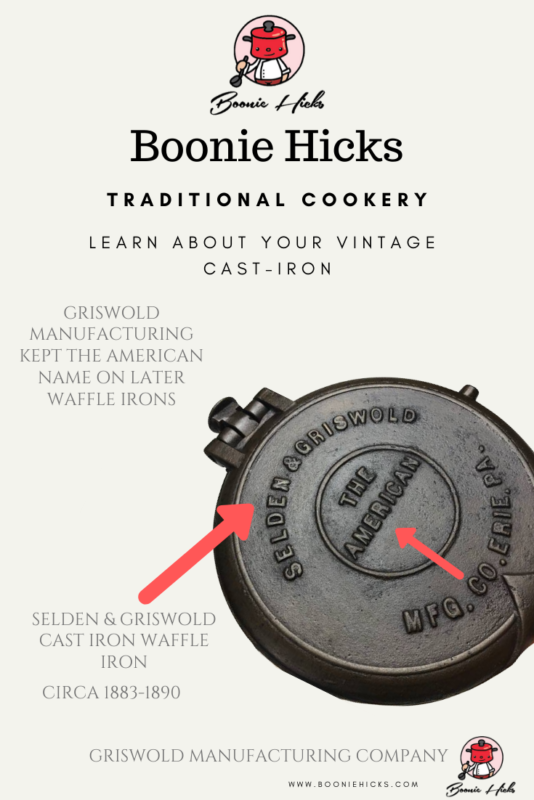
How Old Is My Griswold Cast Iron Skillet? Logo Approximate Dates
“Erie” Logo | Made around 1880-1907 |
Griswold’s Erie (Griswold diamond logo) | Circa 1884-1910 |
Style changed Griswold’s Erie | Circa 1905-1906 |
Griswold introduced a new logo design known as the circle cross logo. Slant Logo | With heat ring circa 1906-1916 |
Slant Logo With E.P.U. | Circa 1906-1929 |
Slant Logo Without Erie | No Erie under logo circa 1909-1920 |
Griswold With Large Block Logo | Without italic lettering, 1920-1930 |
Large Block Logo (Without Heat Ring) | Circa 1930-1939 |
Griswold Large Slant Logo (Without Heat Ring) | 1939-1944 |
Small Block Logo | Notable reduction in logo size. Circa 1939-1957 |
Erie Cast Iron (Approximation Date 1880-1907)
Erie cast iron is one of the most sought-after vintage cast iron brands you can collect. Griswold used this logo between 1880 and 1907.
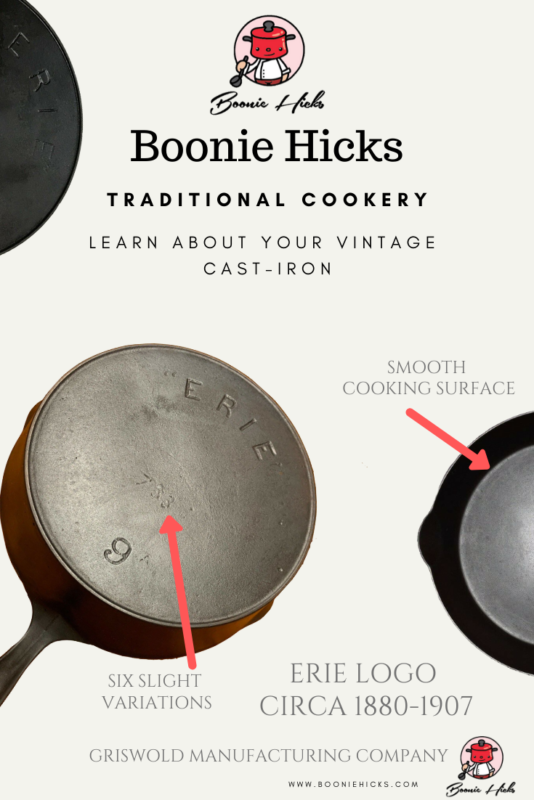
Erie cast iron skillets are very thin and light. Because of this, they are more prone to warping. So when you buy an Erie online, ask the seller if the skillet rocks or spins. That said, I would not look past an Erie skillet just because it has a little movement.
Erie skillets are also known to be super smooth and are often priced similarly to other vintage pans.
Some foundries used Erie skillets as a template to make their molds. So you may find Sidney Hollow Ware and Wapak Skillets with an Erie ghost mark.
If you have an Erie skillet, you can further break the Erie logo into six different variations. The Wagner and Griswold Society has an article on the markings and variations of the Erie skillets.
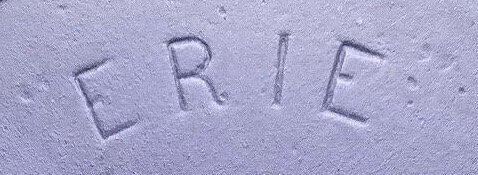
Diamond Logo
Look at the back of your cast iron Griddle, and if you see a diamond logo. Then it is your lucky day. The Griswold Diamond logo is an early logo that is more scarce than other logos.
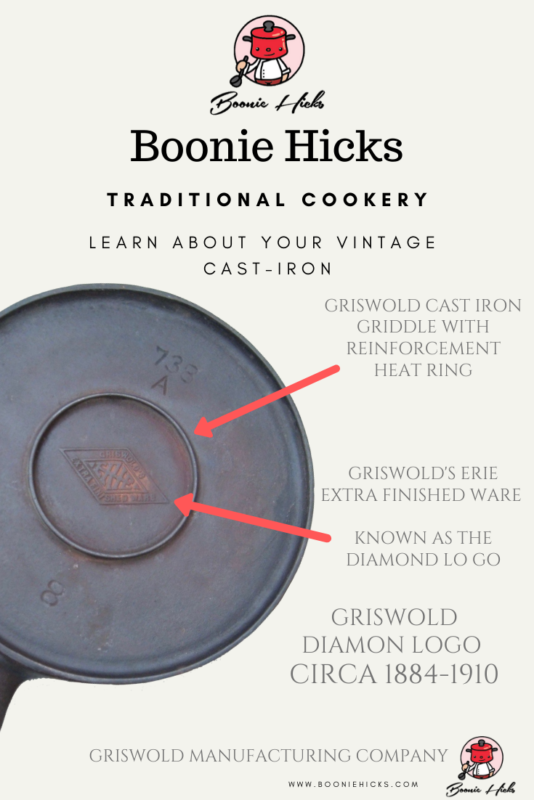
Griswold manufactured griddles with this logo circa 1884-1910. The logo is in the center of the backside. Unfortunately, the center is an area often damaged by sulfur pitting.
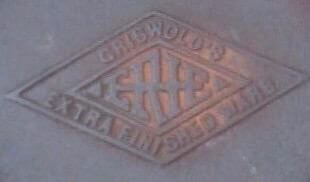
Griswold’s Erie Trademark
Griswold used this logo somewhere between 1905-1909. There are conflicting dates, so I used a conservative timeline. Since Griswold used the Griswold’s Erie logo for a shorter time, these skillets can be harder to find.
The Griswold’s Erie logo is the first Griswold logo. It transitions from previously used Erie logos to Griswold logos. However, Griswold’s Erie logo shares similarities with Erie skillets.
Sizes
Look for Griswold’s Erie skillets between sizes 6-9 and 11 to 12.
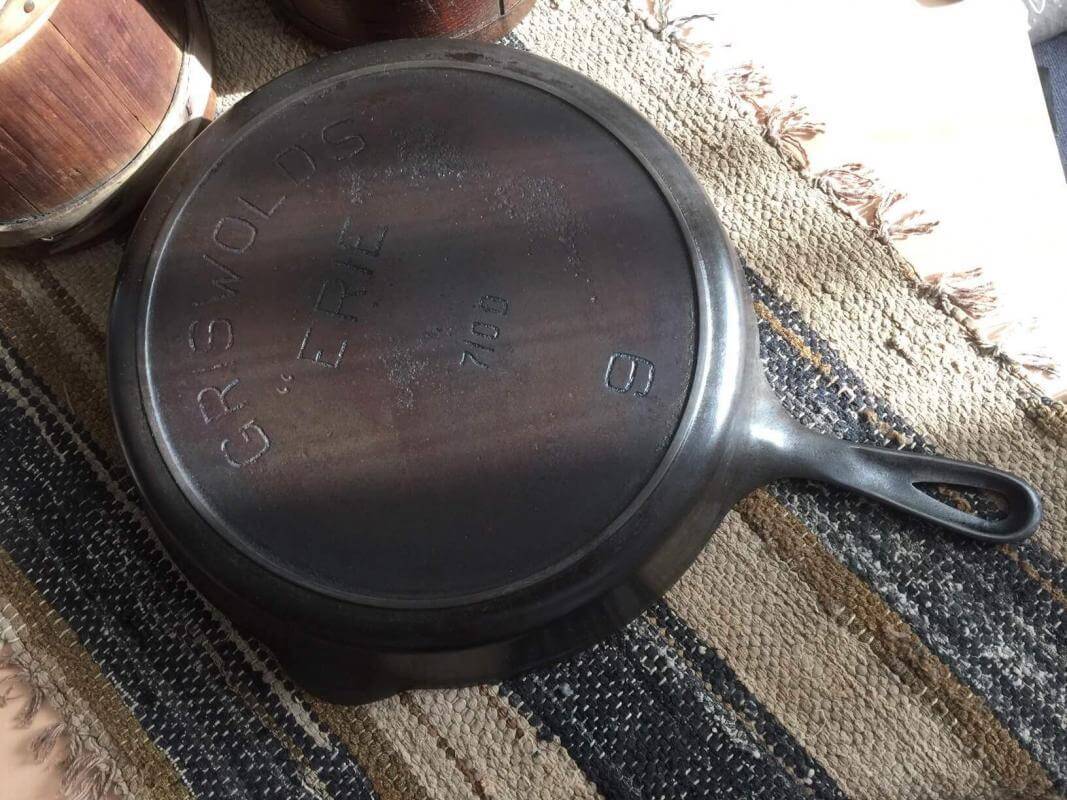
Griswold Slant Logo With Heat Ring And No E.P.U.
The slant logo is the first of the famous Griswold skillet logos. The Griswold Manufacturing company used the Slant trademark from 1906 to 1916. these dates give a slightly broad timeline, and cast iron enthusiasts would narrow this timeline down.
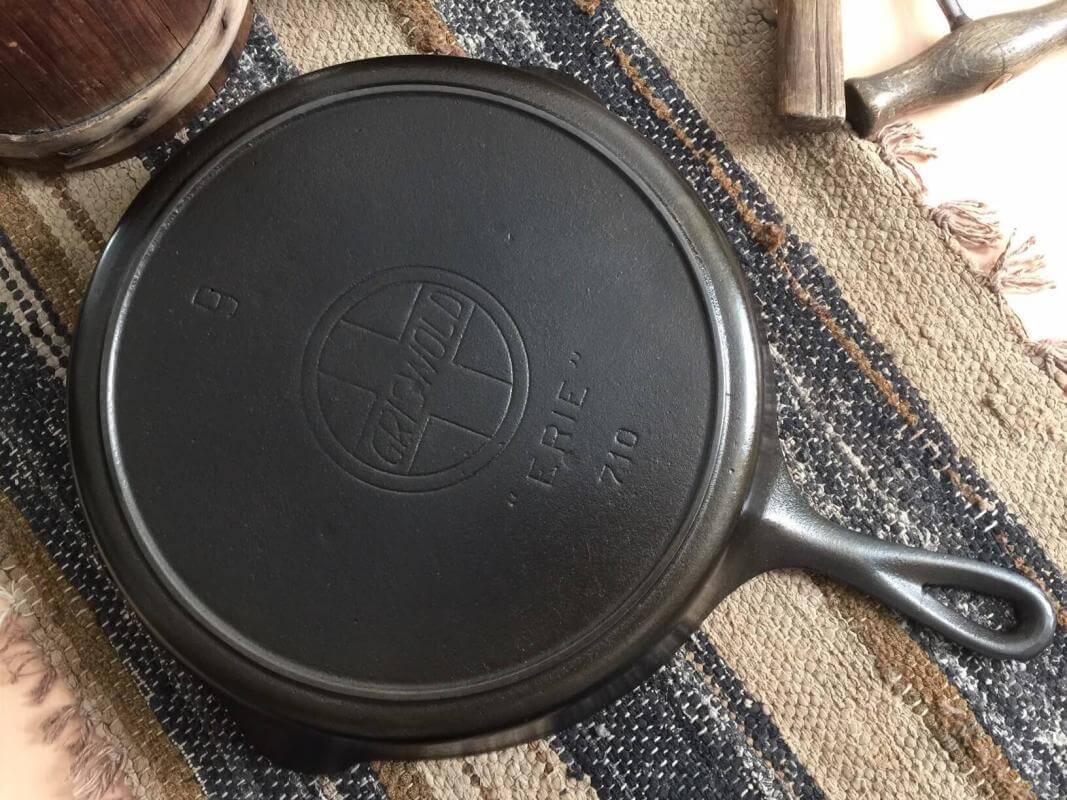
The Griswold slant logo is easy to recognize with the word Griswold in italics. Also, the Slant logo has characteristics that differ from Erie and Griswold’s Erie skillets.
Changes Griswold Made On Their Slant Logo Skillets.
- The size number on the base of the skillet moved from the 6 o’clock to 12 o’clock position.
- The word Erie is below the Griswold logo. The early Erie skillets have the marking at 12 o’clock.
- The pattern number moved from the center of the skillet to 6 o’clock on the skillet to make room for the Griswold circle cross logo.
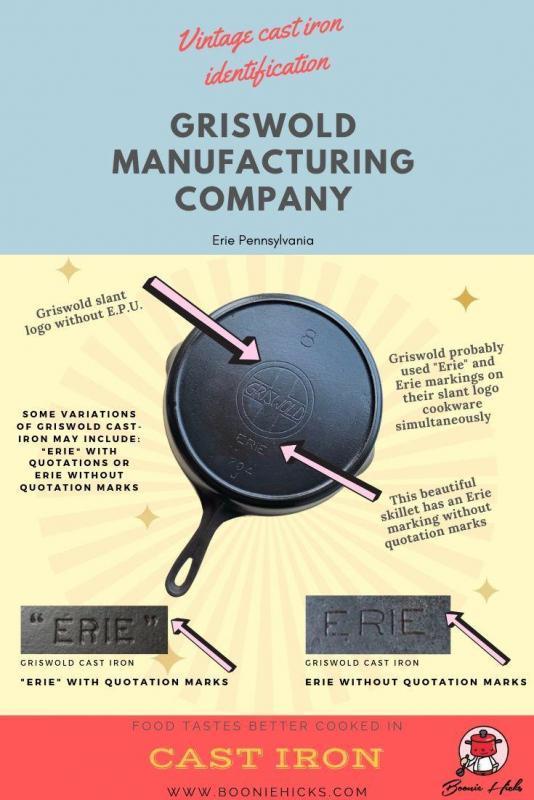
Griswold Slant Logo Sizes
Slant logo sizes range from 1-14. The largest skillet with the Griswold Slant logo is #14. A Griswold #13 slant logo can cost thousands of dollars to the serious collector. The skillet has to be in excellent condition to achieve this price.
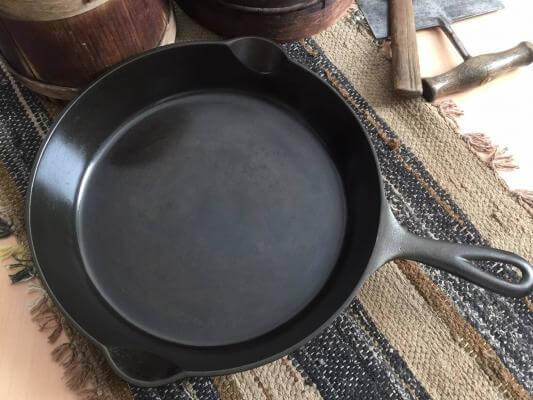
Griswold Slant Logo With E.P.U. And Heat Ring
The Griswold slant trademark changed to add the words cast iron skillet in an arc at 12 o’clock on the skillet. The E.P.U. refers to the wording Erie PA., U.S.A., on the skillet.
The slant logo, however, remained the same. Again, I cannot pinpoint the exact date of manufacture of the Griswold slant logo with E.P.U. If you have a Griswold slant logo with E.P.U., the manufacture date is around 1909-1929.
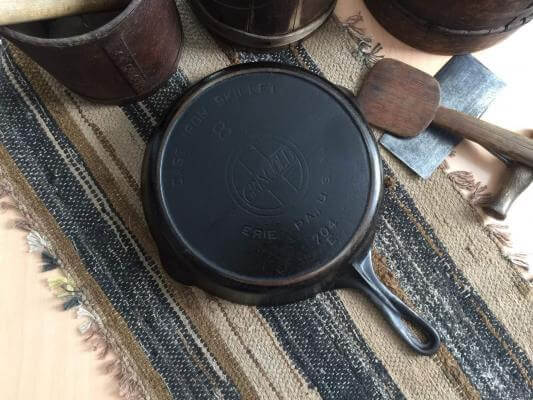
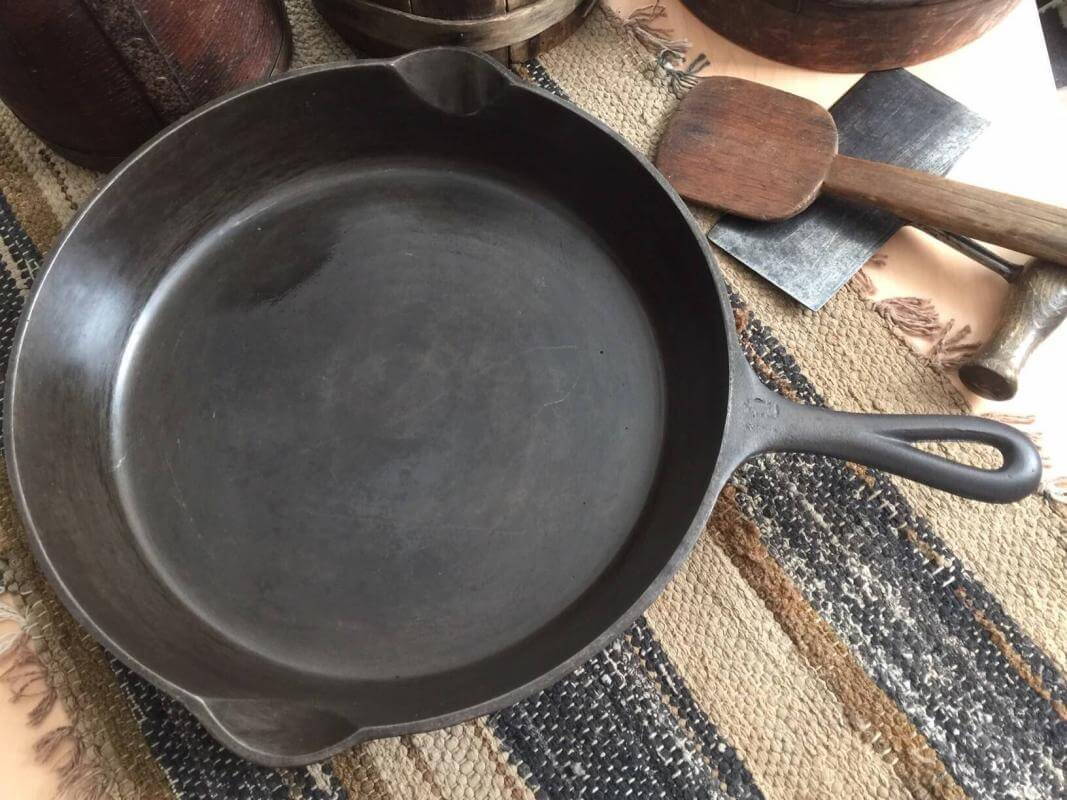
Slant Logo Without Erie Marking
I have only seen this trademark used on a few Griswold cast iron skillets. It seems to be quite rare. The logo is the same as the Slant logo without the E.P.U. wording on the skillet. This logo also omits the marking Erie.
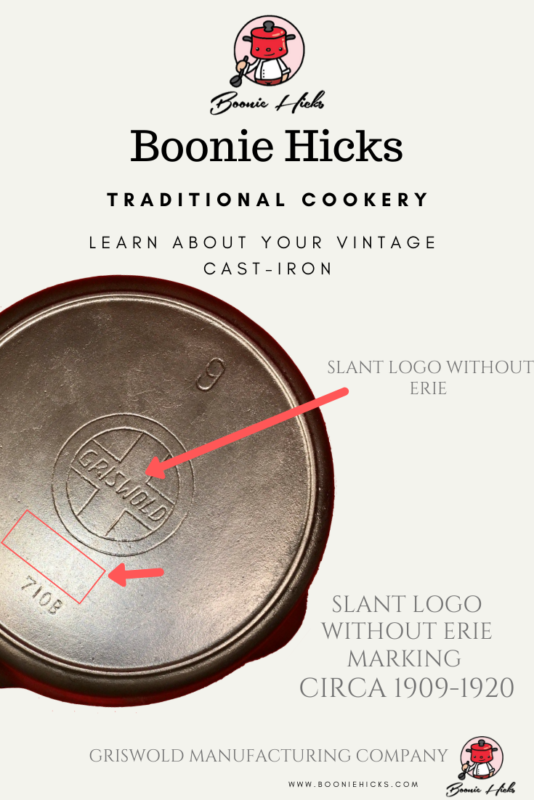
Griswold cast iron skillets without Erie marking have a manufacture date of around 1909 to 1920.
Sizes available: I have only seen the large slant logo without Erie on size #9 skillets. I do not know of other skillet sizes that came with this logo.
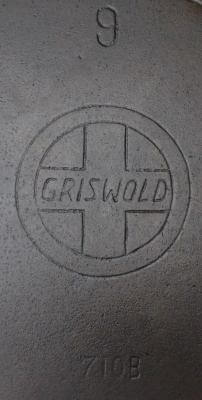
Large Block Logo (With Heat Ring)
The large block logo is one of the more popular markings or trademarks. It is known as the Griswold block logo. The block logo is very similar to the Slant logo. However, the word Griswold is no longer in italics. Griswold is in straight-block lettering.
Skillets with the block logo are circa 1920 and 1930. Griswold also manufactured a wide range of sizes ranging from 0 to 14. However, Griswold Manufacturing also made a number 20.
The Griswold #20 is a massive skillet and can cost a pretty penny online. It is called the Griswold Hotel Skillet.
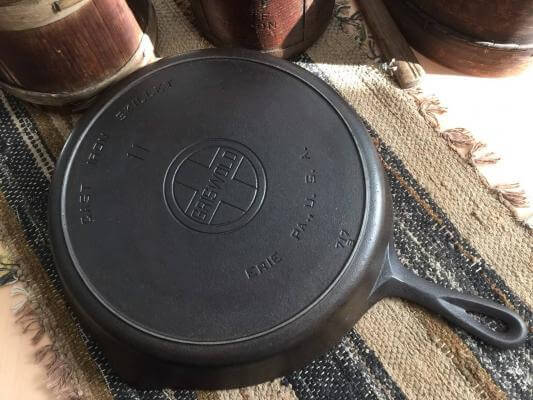
Large Block Logo Without Heat Ring (Smooth Bottom)
Griswold also put the large block logo on cast iron skillets with a smooth bottom rather than the familiar heat ring. However, the sizes were more limited. Look out for sizes between 2 and 10 to collect a complete set.
Smooth bottom skillets are not as sought-after to collect as skillets with heat rings. So you can expect to pay less for a Griswold without a heat ring.
Why the change? Cookware with heat rings was for use on wood or coal ranges. However, with the introduction of electric cookers, cast iron cookware with heat rings slowly gave way to cast iron skillets without heat rings.
Do you want an excellent old skillet without the price tag of highly collectible pieces? Then, using a skillet with the Griswold Large Block trademark could be a great option.
Griswold made skillets with the large block logo and a flat bottom between 1930 and 1939.
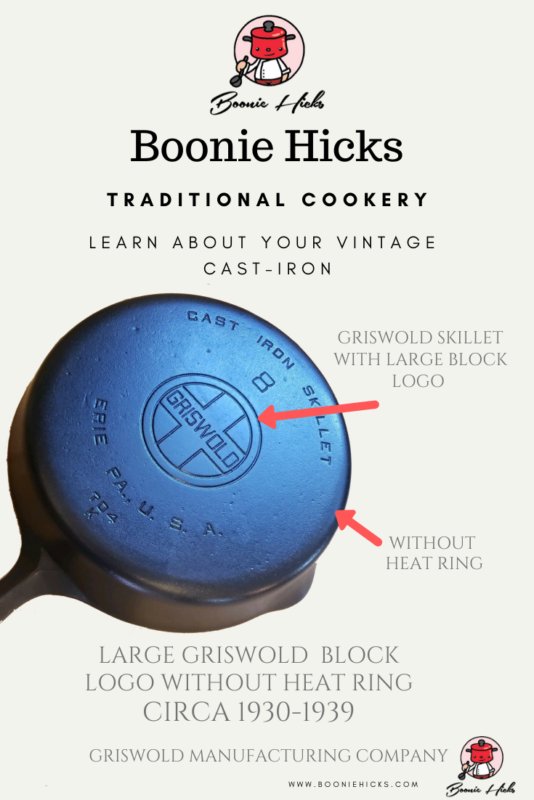
Griswold Slant Logo Without Heat Ring
Griswold also used the Slant logo on smooth bottom pans.
However, slant logos on skillets without a heat ring are not as common as skillets with a heat ring. These pieces sell at a similar price to a smooth bottom Griswold with a block logo. Griswold made these skillets between 1939-1944.
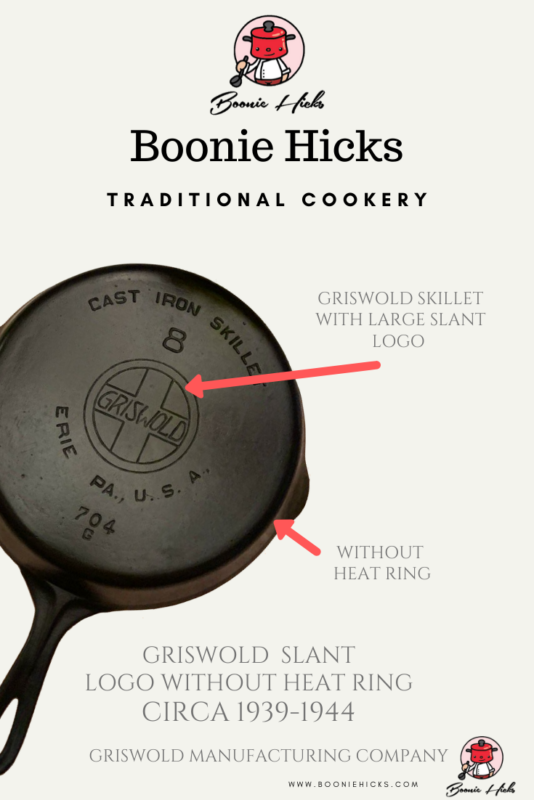
Small Block Logo.
The Griswold Small Block marking is not as collectible to cast iron enthusiasts, but they are still fantastic skillets. Griswold drastically reduced the size of the logo, and skillets came without a heat ring. Skillets lost much of their character. But there are some beautiful skillets around with the small block logo.
Watch out for sellers pricing these skillets at high prices because you can expect to pick up a skillet with the Griswold small block logo at a lower price than more collectible skillets.
That’s not to say the small block skillets are any good. But the small block logo is not as collectible so that you may pick a good skillet at bargain prices.
The Small Block logo is from circa 1939 and 1957.
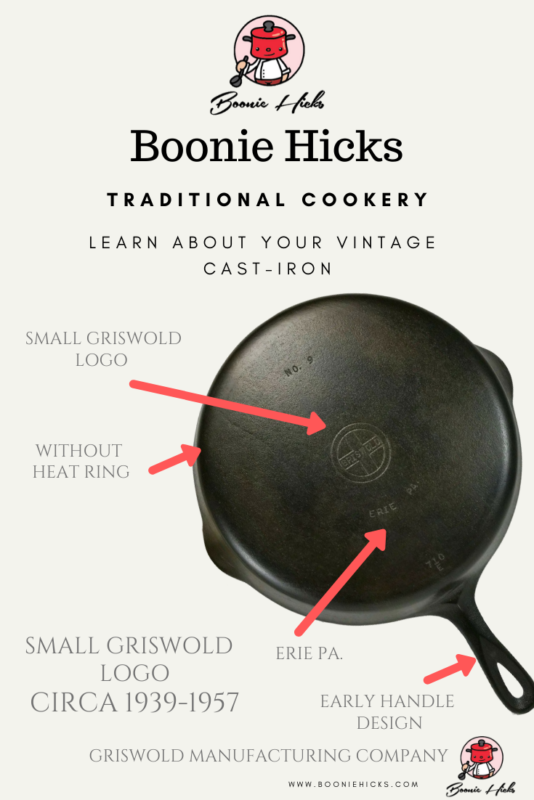
Do you have a skillet with a small block logo? Then check out this article. You will learn three different handle types to estimate the age of your skillet better.
Griswold Manufacturing’s Big Brands Were Erie And Griswold. But They Also Made Cast Iron Cookware Under Different Brands.
The Griswold Manufacturing Company, like other foundries, made a lower-grade range of cast iron cookware and was more budget-friendly.
Griswold Manufacturing Budget-Friendly Line.
Victor | Circa 1890s to the 1930s. |
Iron Mountain | Circa 1930s-1940s. |
Victor Cast Iron is A Budget-Friendly Brand Manufactured By Griswold.
Victor was a budget-friendly line of cast iron. Griswold made Victor Skillets between the 1890s and 1930s. The logo has also changed over the 50 years, with Victor at the 12 o’clock position like Erie skillets. However, the Victor logo on the cast iron skillets became embellished over the years.
Griswold Manufacturing marketed Victor cast iron as a lower grade. But this does not mean lower quality. The skillets still have super smooth cooking surfaces.

Do you have a piece of Victor ironware? I have written an identification guide to estimate the age of your pan. Click on the link to learn more.
Iron Mountain
Griswold made another lower-priced range of cast iron known as Iron Mountain. Unlike other cookware made by Griswold Manufacturing, the Iron Mountain range does not have a logo or trademark on the ironware. Without any markings, it is harder for non-collectors to identify the skillets.
But there are a few characteristics that the Iron Mountain skillet series has that can identify them. Look for a rectangular hole in the handle.
Griswold made Iron Mountain cast iron between the 1930s and 1940s. Since Iron Mountain cast-iron was a budget line, it is probably not a surprise Iron Mountain skillets have a heat ring for use on older wood and coal ranges.
.
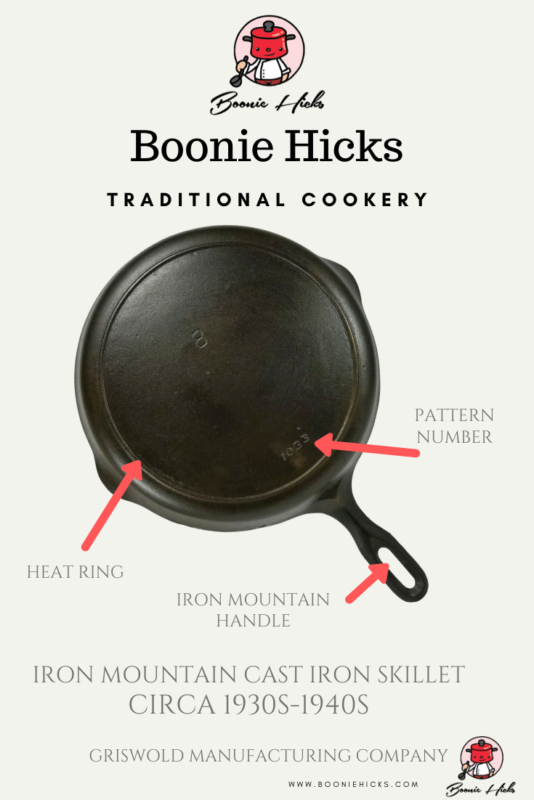
Griswold Manufacturing Made Skillets For Other Companies.
Sears contracted with Griswold Manufacturing Company to make cast iron cookware for their department stores. The Cast Iron Collector also has information on cast iron store brands. Griswold store bands that included.
Store brands manufactured in the Griswold foundry.
Best Made | Manufactured in the 1920s |
Puritan | From the 1920s to the 1930s, Griswold Puritan cast iron had a pattern number at 6 o’clock. If you have Puritan cast iron, click the link to learn more. |
Good Health | Made from the 1920s to 1930s |
Merit | Circa 1920s-1940s |
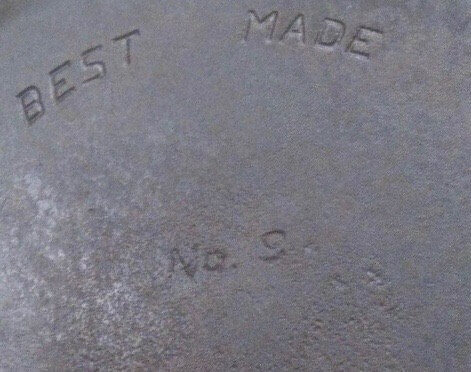
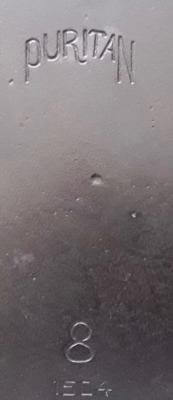
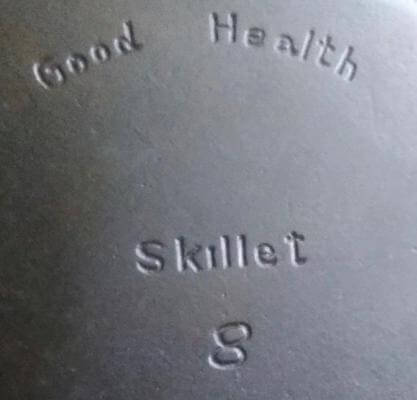
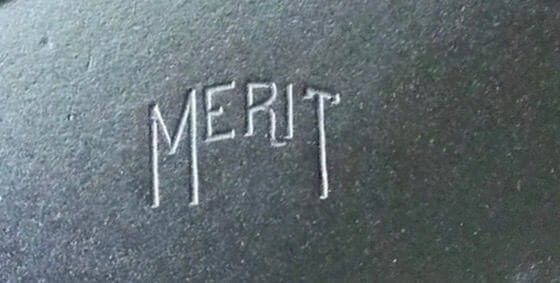
Griswold Skillets Are Great, But Take Your Time Buying One.
Suppose you have a Griswold Cast iron skillet. Then you should be one proud owner. Many pay a premium for Griswold cast iron skillets. However, the word is out Griswold to the name to collect. And some sellers are asking hefty prices. Just take your time if you want to buy one of these beauties.
Griswold Made Other Brands.
Do you have an Erie or a Griswold? Then you have yourself one fine skillet. But the store brands and the Iron Mountain range are good as well. Even though smooth bottom skillets are not as collectible, many prefer them on modern hobs.
There is good reason Griswold has the reputation of making some of the best antique cast-iron you can cook with.
Enjoy your skillet.
Helpful Articles For Further Reading On Griswold Cast Iron.
Once you have finished reading this article, I have written beginner’s guides to Griswold skillets. To help non-collectors use and enjoy their Griswold ironware.
- Where are the best places to buy Griswold ironware as a novice?
- How can I spot faults in the skillet and avoid overpaying?
- Is my antique skillet worth anything?
- Should I buy a Griswold cast iron skillet?
If You Have Enjoyed This Article, Check Out My Other Articles On Vintage Cast Iron.
- Wagner Wagner was Griswold Manufacturing’s main Competitor.
- Wapak Hollow Ware used Erie skillets for templates for their cast iron skillets.
- Favorite Stove And Range made excellent cast iron. Favorite Piqua Ware, in my opinion, is equal to Wagner and Griswold.
- Sidney Hollow Ware is one of my favorite makers. They also made their cast iron extremely light.

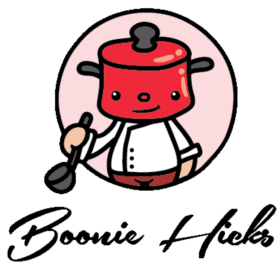
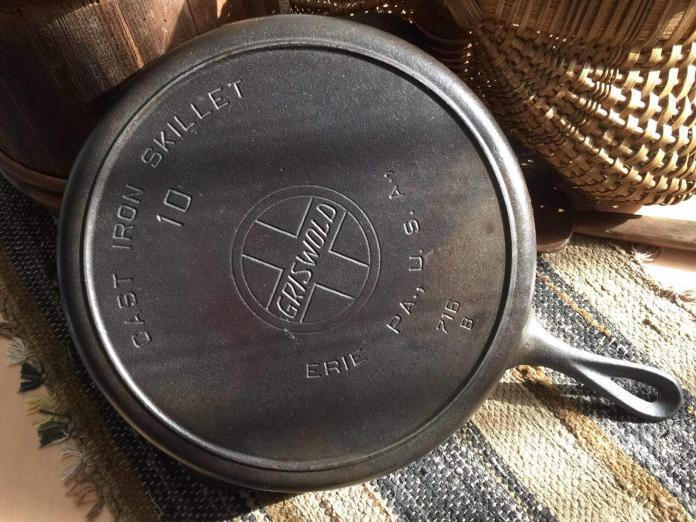
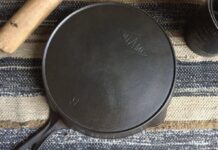
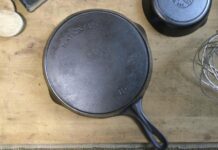
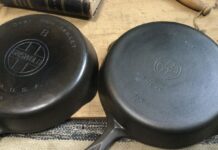



I just want to say thank you for this article. I appreciate your obvious love for the cast iron skillet. I have my Grandma Alice’s Griswold that is absolutely priceless to me. I plan to pass it onto my son one day. Best Regards.
Hi Tonya
Thank you ever so much for your kind words. I’m pleased you enjoyed reading the article. And it sounds like you also love your ironware. Great to hear your Grandmother’s pan is in safe hands.
Cheers and happy cooking
I have a Griswold skillet small circle logo
Erie , #8 , 2028. It is missing the hinged lid. I am not sure how to go about finding the correct size. Will most griswold #8 lids fit it .
Thanks
Hi there Andy
Wow, a hammered finished Griswold lucky you.
Unfortunately, I don’t have a hinged skillet to compared the circumference. But I would recommend taking accurate measurements and getting in contact with the seller before purchasing any lid. I’ve heard of people purchasing a cover only to find out it was made for chicken fryer.
With any luck another collector can confirm Griswold skillet covers can be used on a hinged skillet.
But enjoy your skillet Andy, and hopefully you can find an original lid.
Hi Boonie,
Happy Thanksgiving and hope you are staying safe! I really appreciate your thoroughness with this site as I have just gotten into cast iron skillets. Thank you for all the amazing details! I actually have a few questions. Do you know what the letter on a skillet (i.e. “704R”) represents? Does electrolysis affect quality? Also, are self-basting covers just as collectable?
I sincerely appreciate all your insight! Thanks so much,
Sam
Hi Sam
Thanks for getting in touch and kind wishes.
The number on the bottom your skillet is a identification mark that was used by Griswold. Today collectors can use this marks to identify the size of a pan. In the case of your skillet a number 8. The letter following indicates the mold used to make your pan.
Electrolysis is considered a safe and gentle way to remove seasoning from cast-iron. It is a method preferred by many collectors and those that restore cast-iron. There are some good videos on YouTube to learn how to safely set-up and use an electrolysis tank.
Keep an eye open for those lids and covers. Some lids command healthy prices online for those needing a cover for their beloved Dutch ovens and roasters.
Happy Festive season Sam
Cheers
I purchased items for an estate recently, and have found what I think is a super rare Griswold cooker, with a porcelain oven. It seems to be in good condition.
Hi Eric
That’s a nice find. Griswold manufactured a wide variety of cookware including stoves and ovens. And you’re right, you’ll rarely see these ovens on the market. If you want to learn more about your Griswold oven. I recommend joining a few Facebook groups, and reach out to a collector that specializes in antique cast iron stoves.
Thanks for sharing your find.
Hi Boonie! I’m part of a FB group where a “debate” is going on about whether a Griswold Dutch Oven is a matched set with a lid. The lid is a #10 with a slant logo with EPU, and the oven is a large block with EPU, with the “Pat March 16 20” on it as well. The game changer? It’s NOS. Oven still has the label, the lid still has the tag. Story is it was in the attic of an older woman, to whom the Dutch oven was given to her mother. Do they match? Could it have been sold during the transition between the two logos?
Hi Ashley
Thanks for the contact. A healthy debate is always a way to discuss different opinions and come up with new ideas and theories. It also makes collecting cast-iron fun as you learn something every day.
Dutch ovens are tricky, unfortunately there is little information available, and an accurate timeline is hard to put together. Online information such as mine may inadvertently add to the confusion as the guide focuses on skillets rather than Dutch ovens. I hope to put together an article on Griswold Dutch ovens sometime in the future. But I’ll need to collaborate with a few collectors to piecemeal a rough guide.
As for the debate, it’s an interesting one, probably by two knowledgeable collectors. At best, I could only add to the discussion. And I believe both opinions have merit.
A Griswold oven with a slant logo and large block lid is not uncommon. And if I were a seller, I would have no problem labeling them as a set.
However, I would make sure not to label them as a matching set. As the logos don’t match, and the owner might have purchased the lid at a later date. Although the original owner most likely purchased the complete oven with two different logos at the same time. It may be semantics, but I’d try to avoid any potential disappointment from a buyer.
Cheers Ash, have a great weekend.
Hi Boonie,
Just happened to see this note as I am in the process of “cataloging” our collection and noted the same set of circumstances as Ashley above has noted.
Block circle cross on oven and slant circle cross on lid. In our case the large dutch oven (12 1/4″ dia.) with legs has THE GRISWOLD MFG CO (all arch, block print), CAST IRON, TITE-TOP DUTCH OVEN, block circle cross logo, (in 6 o clock position) 310, PAT’D, MAR. 16. 20.”
The lid has a 10 in the 12 o clock position and slant circle cross in the 6 o clock position. The lid has an ash rim and so is 13 1/2″ O.D. For outdoor use with coals, we believe the legs on the oven and ash rim on lid are an appropriate pairing, regardless of original production!
Curious though. Thanks for your hard work on this site. Great info! Susanna
Hi Susanna
Thanks for sending in a description of your Dutch Oven with mismatched logos. It seems quite common to have the oven with one logo and a cover with another.
Cheers and I’m glad you enjoy the site. Happy cooking
I have found a Griswold #240 Turk head muffin pan, how rare or collectible are these?
Hi Robert
Well done on your find. Yes, it sounds like you have a relatively scarce pan. I believe Griswold made these collectable pieces circa 1930s-1940s.
The Turks Head can be tricky to season, but they are great looking pans. I’d say you did well picking it up.
I have a Griswold griddle. It measiures 24″ incliding handles, 22 without. On back it has #9, below that Cast Iron Griddle. Below the logo Erie,PA and further down 909 with an A under the numbers. Any idea on age or valur. I have no memory of where my husband or I where we got it from. Thanks
Hi Joan
Thanks for sending in a question.
Wow, you have a nice big griddle. And the 909 pattern number indicates you have a Griswold Long Griddle, with a small logo. Unfortunately, griddles don’t hold much monetary value compared to vintage skillets. But the sold listings on eBay should give you an idea on how much it’s worth.
I believe Griswold made these griddles circa 1950s.
Cheers Joan hope this helps.
I have a griswold skilet but it does not match any of the pictures I see. It has the small griswold logo . Under the logo it has 7 inch skillet then under that the letter B. I am wondering how old
Hi there Mike
Thanks for your question.
It’s sounds like you have a Wagner skillet made in the circa 1960s. It’s a later version of Wagner Ware, but they are very nice pans. And I guess the cooking surface is very smooth.
Happy Cooking
Hi Boonie, I’m in search of a dutch oven and just today came across a ERIE (no quoatiion mark) 8 Bean pot kettle with side rings and matching lid. From what I can see it also possibly says PAT MAR. 10. 1891 in the center of the bottom. the Word ERIE is on the bottom outside rim with no other words. It also has a large 8 on the bottom. Cant tell if lid has number no photo of the underside of lid.
Any idea on the age or value of this piece they are asking $40. If older then 1920’s I think that’s fair. Just wondering if you know about the age when it says PAT MAR. 10 1891 and what year of production that was made, since I didn’t see it in any of your photos above.
Thanks,
Gary
Hi Gary
Thanks for your question.
It sounds like you have your eye on an early Griswold Dutch oven or kettle. I think the price they are asking is fair. And I would be very happy with the purchase. Older kettles especially footed kettles are in less demand compared to Erie skillets because of how we cook today.
But I would jump at the chance of buying this old oven/kettle, and when not in use it would make a wonder kitchen display. The lid is an added bonus. Hopefully the lid is flat to complete the old-time look.
I suspect the oven was made circa-1980s-1900s. I don’t think it would be older than 1910. And a possible end of production date could be closer to 1905. As much as we look to the past, the those in the Victorian era were looking forward to the new century, and the date of the pervious century might have been perceived as outdated or fuddy-duddy. So I think it’s a late 19th to early 20th-century piece.
Hope this points you in the right direction.
I found a small Griswold pot with lid today at a flea market. It is 4” across and 2.75” high. Would you have any clue as to what it was used for or how much it would be worth?
Thank you,
Pam
Hi Pam
Thanks for your question.
Griswold produce a number of smaller sized pans and Dutch Ovens. Some were toys, others were used to serve individual portions similar to how we use ramekins. Does your Griswold pot have any markings on the base to give us more information? I think your pot could be a patty bowl. And used to make individual pastry cases for savory dishes or desserts using Griswold patty molds.
But any small cast iron pot with a pour spout and handle could be used for smelting metal. And I would urge caution if you want to use it for any food preparation as it could contain a few nasties.
Hope this gives you an indication on how these small pots were used.
Cheers
Hi Boonie,
This was an informative and clean crash course! Thank you! I’ve been using small block Griswolds ever since I found one in a thrift store right outta college — haven’t looked back.
You say Griswolds are collectible for “their smooth cooking surfaces and lighter weight,” but then say the small block logos are “less collectible” but still a decent cooking pan…
My question is: exactly how is the small block logo less desirable?
Is it the lack of heat ring?
Is the logo too shy?
Are they heavier than earlier pans?
Do they have a rougher cooking surface?
Is the handle less comfortable? Less attractive? Shorter?
Were post-war materials inferior? If yes, how?
In short, if you ignored the handles and cooked the same dish/meal in different eras of Griswold pans, what would be the difference? I love the smooth cooking surface and the clean lines of these cast irons, but the jump in price from SBL to other eras has always confused me.
Looking forward!
Hi Eli
Thanks I’m glad you enjoyed the article. The identification dates are conservative, but think it gives an easy to understand estimate for those new vintage ironware.
If you see a Griswold skillet with a small logo go for it. They are great pans, and you’ll find beautiful examples for sale. I’m sure you’ll be pleased with any Griswold made skillet and they will cook meals the same.
I think the small logo loses the old world character of antique ironware. But the pans still have a smooth cooking surface and there’s nothing wrong with the metal.
In the article, I wanted to highlight the large Griswold logos are more collectable. To help those new to collecting, not to rush to buy the first Griswold pan they see. Buyers might want to hold off until they find their favorite logo. And hopefully to prevent readers from paying too much when they find a Griswold for sale.
I hope I’ve answered your main questions. I have plans to write an article on the Griswold small logo in the future. To help owners identify and date their pans from the different types of handle design. And I’ll be sure to add your questions too.
Thanks for your help.
I’ve really enjoyed reading this very informative article- thanks for sharing your obvious passion.
I have recently inherited what I’ve identified as an Erie 9, 2nd Series cast iron skillet. After doing some research online I was surprised to realize how old it is. While I have cleaned it and re-seasoned to be usable I would like to remove the caked/ burnt on grime from the center bottom and around the sides. While the pan sits flat, there is slight upward warping in the center of the pan. What would you suggest as a cleaning method that would prevent any further damage from occurring.
Also, we have been using this skillet regularly… would you have any concerns about continued use?
Hi Adam
That’s brilliant, I’m really happy you have found the article useful.
The second series Erie skillets are old-timers that’s for sure. You’re lucky to have one, and I wouldn’t worry about the upward bow. Think of it as health benefit as the grease will drain off to the sides. Good on you for cooking with the pan, they were made to be used.
If you have cleaned and striped the old seasoning as a precaution, I’d have no concerns using the skillet. Restoring a single skillet, I recommend watching a YouTube video on “How to strip seasoning off cast-iron using self cleaning oven?” Basically this method burns off the old seasoning in the oven set at a high temperature. But make sure it’s a nice fine day, so you can open up all the windows, because it will get smokey.
Have fun with your restoration project
I found an Erie Dutch oven. Bottom says “ERIE” with 834x and the number 9. The lid only has a pattern number 834c. I’ve seen the same Dutch oven with different lid numbers which are usually marked with the Dutch oven size. Is my lid not a match? I’ve googled and googled and have yet to find that lid number for an Erie Dutch oven.
Hi there Jen
Thanks for your question, and I’d say you have a matching lid, later lids had a four digit pattern number. And it matches a size 9 oven. I guess the lid is flat rather than domed. This is another indication of the lid design used during the time. I have also seen a few of these ovens without a cover so you’re quite lucky.
Cheers, hope this helps
Interesting. I’ve seen the same Dutch oven with an 838 lid, just never a lid number matching the Dutch oven number. Thanks!
Also the 834 loud is slightly domed, not flat like the 838. It looks exactly like the 2552 lid.
Thanks Jen
You really have done your research. Hopefully, another collector or owner will be able to add to the conversation. And cross reference your lid with theirs.
If any owners can help out please feel free to comment below.
So, A few days ago I came across a 610 griddle. I already had one with large logo. The one I found was pretty beat up and was really dirty so I set in oven on clean cycle and it came out pretty clean. I assume it’s from 1930-39 large block letters and logo, but what has me asking questions is it’s either aluminum or Du-Chro.. I can’t find images anywhere of this style. Is this griddle very rare? Also what do I need to do now to season it? It’s very shiny.
Thanks, Ryan
Hi Ryan
Thanks for your question, and congratulations on your purchase.
Plated griddles are around, but you’re right, they tend to be more scarce than regular cast iron griddles. Your plated griddle could be Du-Chro. But you describe the griddle as shiny, that leads me to suspect it’s chrome plated. Chrome has a polished look and is consistent with the time. The griddle could be late 1920s but circa 1930-1940 with chrome plating seems more likely.
Multiple layers of seasoning will be needed to cover the sheen. But, you’ll get there.
Sounds like fun, enjoy your griddle.
I bought what I think is a Griddle ..it has a raised up cross and says Griswold in a circle has #8 and ERIE738 A and I think a spider logo on the handle….I gave 25 cents for this what would be the value ?Thank you so much
Hi Elizabeth
Wow, it sounds like you’ve found a bargain. You can check the sold listings on eBay for selling prices. But there’s no question it’s worth more than .25c. The spider logo is very interesting, and I’d love to see a picture.
If you have time to send through a picture, here’s my email booniehicks@gmail.com
Cheers Liz, well done on your purchase.
Hi there, I’ve got a #8 large block letter Dutch Oven with bail and an aluminum “Griswold” branded drippings “tray” or whatever it’s called. I don’t know if that’s original to this piece or not. The bottom markings match those of the 1930-39 skillet pic. 1278C. The lid fits tight, and has 3 concentric rings and an “8” cast into this inside of the lid. There is a faint cross in circle as well. I bought it an antique shop around 15 years ago, and it must have seemed reasonably priced. I was thriftier then… The metal on the exterior seems just shy of perfect, but the inside needs attention. It looks like someone seriously burned the contents then tried to scrape it out with a screwdriver 😬. Since the exterior looks so good I don’t want to burn all of the seasoning off. But that may ultimately be the best choice. I will try vinegar and elbow grease first!
I’ve also got an old #8 unbranded Wagner, marked with the “8” on the top of the handle, “10 1/2 INCH SKILLET” and “D” below that, and “D” again on the underside of the handle. I foolishly gave away the other two sizes which nested inside this skillet, but at least they went to a guy who also appreciates cast iron. The #8 is unfortunately warped and spins on my induction cooktop. I have read how to repair it, and I’m frankly not in a hurry to wang on it with a wood block and hammer! Its cooking surface is smooth and seasoned, and it still works as is of course. I would love to use it more, but the new range is worth considerably more than this old pan! So I may be on the hunt for a flatter vintage piece.
Great site, lots of info here!
Hi Woody
Thanks for getting in touch, and I’m really pleased you are enjoying the site.
It sounds like you’re a cast iron enthusiast like myself and many of the readers. And it’s neat to hear how other enthusiasts come about ironware and what pieces everyone has. I’d trust your identification, it sounds like you are quite knowledgable on vintage ironware.
I also use an induction hob over here in Japan. Fingers crossed it remains scratch-free. But I’ve let the kettle run dry a could of times, resulting in a terrible mess.
But if you have your eye on a flat skillet, go for it. I think you can get a silicone mats/liners to protect induction cooktops from scratches, I should really pick one up myself.
Cheers Woods
Hi!
I love this website, all the information is very interesting. I found a Griswold chicken fryer at the swap shack at my dump today. It has only a faint small cross in the center, not italic…no other markings are visible as it has a lot of patina, I guess you would say….should I burn it off in the oven to see more or is that dangerous for the pan in any way?
thanks!
Also, I think it might have directly been put into a fire, not sure, but it def has a lot of black on it….not too much though. I have seen far worse. It’s flat bottomed and sadly the handle has no number either, but maybe the chicken fryers didn’t?
Hi Emily
Thanks for your question, and I’m happy you’ve enjoyed the site.
It sounds like you’re familiar with cast-iron, and I’d go with your instincts and burn off the seasoning in the oven. It’s a gentle way to remove the seasoning. However, as you know, it can be very smokey. So I would try to scrape off as much gunk as possible before putting your pan in the oven.
Fingers crossed the fryer wasn’t used on a campfire. But because of the high temperature of frying, many vintage chicken fryers have a slight rock anyway. Chicken fryers seem to be universally a number 8 across the old manufacturers.
Have fun restoring your pan to its former glory, it sounds like a great weekend project.
I have a #5 with smooth bottom that says Griswold
Hi Monica
I’m really happy you could identify your Griswold using this guide. Hope you found it useful.
Enjoy your vintage hollowware.
I recently acquired Santa and rabbit cast iron cake molds marked Griswold Mfg Co, Erie. PA. Any idea when these were made? Thank you.
Hi Michael
Thanks for sending in your question
I believe the Griswold Santa and Rabbit molds were produced in the 1940s-1950s. If your molds are original they could be worth a pretty penny. Unfortunately, there are reproductions made after 1960.
My Mom is giving me an Erie No 8 Dutch oven/chicken fryer. It has two small handles. I’m trying to date it, but there are no references to Dutch ovens or chicken fryers. There are no other markings outside of the “ERIE” and 8. Any idea as to when this was produced?
Hi Curtis
Thanks for getting in touch. I hope to add information on antique Dutch Ovens in the future.
But let’s try to give an estimate on your Erie Dutch Oven. It sounds like a Dutch Oven rather than a chicken fryer. Chicken fryers like a deeper version of a regular skillet.
You’re very lucky to get your hands on an old Erie Dutch Oven and it sound like an early one too. The original lid should be flat rather than domed. But from your description and no mention of a bail handle, I’d say your oven is circa 1890-1910.
Hey, I hope this helps, and enjoy your old Erie.
My father-in-law gave me a Griswold size 7 “Erie” with heat-ring, he had hanging around. It is pretty rusty. How do I get all the rust off and season it back to its old glory?
Thanks in advance!
Hi Roman
You have a very generous father-in-law. I hope he was able to pass on the history of the pan to you.
If your pan is just a little rusty you might be able to restore it with some steel wool and a vinegar-water solution. Youtube has some very good videos. Type “how to restore cast iron with vinegar”. I’ll get around to doing my own eventually, but my little Japanese apartment isn’t quite set up for restoring cast-iron.
Please be gentle with your Erie skillet and avoid power tools at all costs and then just season with a little oil. You see a lot people recommending flaxseed oil, but I think it flakes too easily. Any old vegetable oil will do.
Good luck with your restoring project.
Have fun.